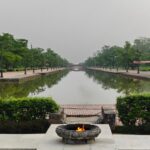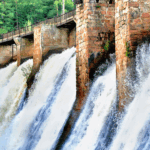The night view of Kathmandu from a flight in the sky seems like a mirror of the stars in the sky. The contrast strikes once you see the urban planning disaster during the day. It makes one wonder how the once well-planned city with a proper water and drainage system turned into this chaos. This article will provide a glimpse of the reason for the chaos by studying the change in urban form with the change in social forms, and a way forward to a more managed city. It will focus on the social change in the growing shift from joint to nuclear family systems, redefining physical space division within the valley.
Evolution of Physical Forms
Kathmandu is an old capital with a rich culture, and a molded social structure and spatial form. Evidence of the old city planning is visible through the Durbar Squares, streets, temples, and waterspouts. Within this structure, Newars, Kathmandu’s indigenous population, lived in a joint family social structure that encouraged patrilineal clan-like culture. This encouraged the clan to build houses around an inward-looking courtyard with limited entry of outsiders to their combined space. Shared courtyards and proximity encouraged interdependence, allowing space for communal activities and rituals. The Durbar Square, temples, waterspouts, and spaces for funeral rites in the old city were planned to facilitate this clan-ism that further disaggregated into the joint family system. These spatial arrangements thus supported the further continued adoption of the social system of joint families. The land and housing policies during the previous dynasties restricted the height of residences for uniformity and structural integrity. These smaller plots outside the core city were once agricultural land.
Over the centuries, the city witnessed gradual horizontal spatial expansion with increasing population due to migration and an increasing internal population. However, in the 21st century, the city witnessed an unprecedented rapid increase in migration that led to rapid urban sprawl. Since the beginning of the century, the city’s periphery has been constantly expanding, with an increase in built-up area of 4.6 times from 1955 to 2003. Expansion particularly accelerated in the past few decades with the built-up area increasing 2.38 times between 2000 and 2010, and further 4.68 times from 2010 to 2020. Similarly, the population has increased 1.57 and 2.47 times during the same time periods, respectively.
Today, land in Kathmandu is largely divided into thousands of individual ownerships. Family-owned agricultural land on the old city’s periphery was fragmented to facilitate the growing demand for residential development. Accommodating the growing demand for residences, built-up spaces in the core city expanded vertically. Expansion in the size of residential dwellings is not a new phenomenon in the Kathmandu Valley, with its horizontal and vertical forms constantly increasing. A previous study on the physical expansion of the dwellings indicates an increase in physical size each time with a new dynasty’s reign. However, these restrictions were gradually relaxed as urbanization increased.
Transformation of Social Dynamics
Within the spatial housing and community that existed, Newars followed a communal living with a typical family living with three generations sharing a hearth under the same roof, and following a patriarchal structure with the eldest man as the family head. This patrilineal Newari social structure enforced a bride to transfer from her natal home to her husband’s home upon marriage, where she lives in a joint family. This forced married women to adjust to new families and limited their agency.
However, rapid urbanization and globalization in the valley increasingly challenge these traditional norms. Kathmandu’s population is rapidly growing with an influx of migrants and an increasing internal population. An increase in migration also increased intercultural contact in the once Newar-dominated valley. Further, globalization has exposed Nepalis to international cultures beyond the geographical border. This influx of multiculturalism exposed the locals to a worldview, challenging the traditional norms.
One such traditional norm is the social structure of living in a joint family. Joint families in Kathmandu are dissolving into multiple nuclear families. This aligns with the theory of sociologists stating that family structure as a social institution is fluid and is in a constant state of change. This increasing shift to nuclear families also indicates the preference of individuals, especially the younger generation, to opt for nuclear over the joint family system. Women prefer a nuclear system as it increases their participation in decision making, ability to exercise agency, and control over income and assets.
A recent study indicates that women’s participation in household decision-making has increased, indicating that nuclearization is increasing women’s power within the household. As women increasingly contribute to household finances, their decision-making power to choose a nuclear family will likely increase. This increase is important as almost 65% of the population in Bagmati province now lives in nuclear families, and almost half of the population in the province lives in the valley. Considering the shift in social forms, the physical forms of Kathmandu must evolve the meet the new demanded realities.
Reconfiguring Urban Form to Adapt to the Shifting Social Form
As highlighted above, growing urbanization and increasing nuclear families in the valley call for spatial reconfiguration to accommodate these modern demands. Accommodating the needs of the growing nuclearization among families in the valley requires fragmenting the family’s inherited land. In Kathmandu’s context, land fragmentation is generally the horizontal division of existing land. Further, nuclearization reduces the inter-generational connection, leading to the old population seeking forced refuge in old age homes and children requiring care from members outside the household. Changes in social form require intricately rearranging the functions of physical structures to facilitate the social change; therefore, carefully transforming the urban forms.
Given the spatial limitation of horizontal expansion due to its geographical bowl-like structure, alternative solutions are required. A remedy is to consolidate the fragmented lands into bigger parcels and expand vertically to supply adequate housing for the growing population. Vertical expansion is the key to resolving the housing problem, as a larger population can be accommodated in a given built-up area compared to a typical Kathmandu residential building. Higher buildings will require a larger built-up area. Hence, land consolidation is equally important in solving the urban crisis.
However, expanding vertically in the city is not absolute. It is precarious due to the valley’s earthquake-prone location and poor soil quality. Proper laws and regulations should ensure that robust and sustainable constructions are built. Furthermore, additional infrastructures, like old-age homes and child care facilities, are required in the valley to accommodate the changing social systems. Kathmandu must reshape its physical form to mirror the changing social form. Only then can Kathmandu shine under the stars — and the sun.
Nasala Prajapati holds a Master’s in Development and Sustainability with a minor in Gender and Development. She is a results-driven professional dedicated to research and initiatives that promote development and reduce inequality, with a strong focus on sustainable practices. Currently, she serves as the Coordinator of the Himalayan Future Forum at the Nepal Economic Forum.





